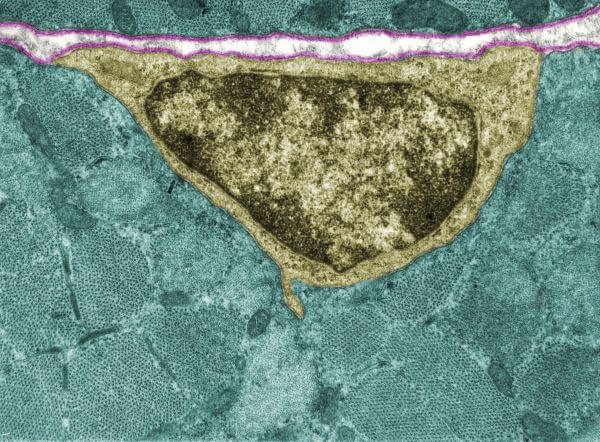Satellite cells are multipotent stem cells of the skeletal muscle tissue, and they play a central role in the growth, maintenance, and repair of the muscles.
These self-renewing cells are found between the sarcolemma and basement membrane of muscle fibers and are quiescent in most healthy, adult muscle tissue. Satellite cells are activated in response to muscle injury, which causes them to proliferate and differentiate to form myoblasts. The myoblasts then become myocytes, which fuse together to form new, healthy muscle tissue.

What Are Satellite Cells?
Satellite cells (SCs) are skeletal muscle stem cells that grow, maintain, and repair muscle tissue. They account for between 3% and 11% of skeletal muscle tissue and are found between the sarcolemma and basement membrane of the muscle fibers.
SCs are self-renewing and multipotent, meaning they can give rise to several other cell types including myocytes (cardiac muscle and skeletal muscle cells), adipocytes (fat cells), and osteocytes (a type of bone cell). They are quiescent in most healthy adult muscle tissue and are activated in response to muscle injuries.

Activation of Satellite Cells
SCs in adult muscle tissues are usually quiescent, which means they are not actively undergoing cell division. They are activated by an injury to the muscle, and will proliferate at a rate determined by the scale of the trauma. In cases of mild muscle injury, just a small number of satellite cells will proliferate. If the trauma is severe, greater numbers of SCs will be activated.
Function of Satellite Cells
Muscle Repair
SCs play a central role in muscle maintenance and repair and are responsible for regenerating muscle tissue in the event of injury. This process is known as myogenesis and takes place in response to both minor injuries (such as microscopic tears sustained through exercise) and more serious traumas.
Injuries to the muscle tissue stimulate the proliferation of SCs, which then differentiate to form myoblasts. The myoblasts then become myocytes; long, tubular cells that fuse together to form skeletal muscle fibers (called myofibers).
These myofibers are the functional units of skeletal muscle and can be used to repair and regenerate muscle tissue in the event of an injury.

Muscle Growth
SCs may also contribute to long-term muscle growth, though their role in this process is still heavily debated.
Studies have shown that SCs are activated by high-intensity exercise. This is often a response to local injuries in the muscle tissue. However, exercise may also provoke widespread activation of satellite cells, which cannot be explained by local muscle injury. Therefore, there is likely another mechanism by which SCs are activated to proliferate and fuse during exercise, and this may contribute to the gradual accumulation of muscle tissue.

Production of Adipocytes and Osteocytes
The primary function of SCs is to repair muscle tissue, and most develop into myocytes
However, satellite cells are multipotent, and can also give rise to adipocytes and osteocytes. Adipocytes are the body’s fat cells and are used for the long-term storage of energy in the form of lipids. Together, they form the adipose tissue (or fat tissue) which can be found throughout the body, either beneath the skin (subcutaneous fat) or around the internal organs (visceral fat).
Osteocytes are the most abundant type of bone cells and account for 90-95% of bone tissue. Their key function is to maintain the mineral composition of bone tissue by depositing and reabsorbing bone, and by signaling other osteocytes in the event of damage to the bone. Osteocytes also regulate the activity of other bone cells (the osteoblasts and osteoclasts).
